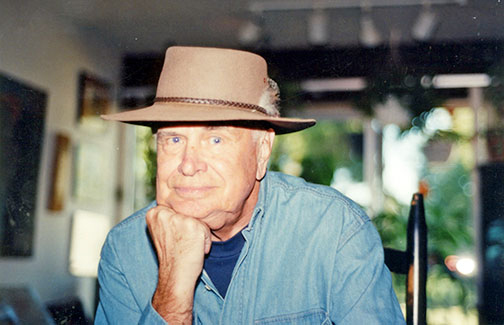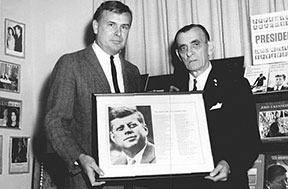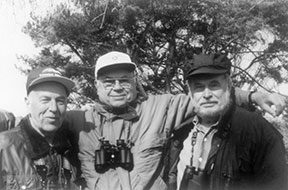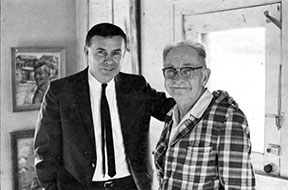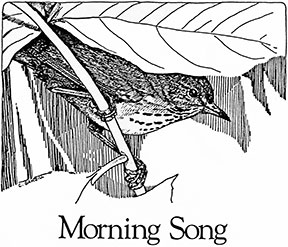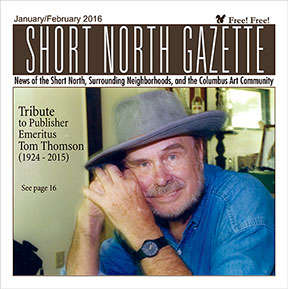
Columbus, Ohio USA
Return to Homepage www.shortnorth.com
Tom Thomson (1924-2015)
Short North Gazette founder spreads his wings and takes flight
By Margaret Marten
January/February 2016 Issue
Return to Homepage
Return to Features Index
Tom Thomson, founder of the Short North Gazette, died December 5, 2015 at the age of 91. Over the past decade he suffered from macular degeneration, dementia, and other health problems. The last few years he lived with his granddaughter Carrie Bailey and remained under her care until he passed away.
The Short North Gazette, launched in 1987 as a 5 by 8 magazine/pamphlet called The Fabulous Short North, was one of several publications he produced throughout his career. Others included This Week in Columbus (TWIC, 1953-57), Columbus Magazine (no connection to existing one, 1958-69), and Good Times (in Columbus and Cincinnati, 1971-80s). His friend, C-J columnist Ben Hayes, was a regular contributor. Tom was also editor of Nationwide Insurance Minutes Magazine in the late sixties.
Tom, whose birth name is Nelson P. Thomson, was born and raised in Columbus. He attended Everett Junior High School and graduated from North High School in 1942. After serving in the Navy during WWII aboard the LSM 245, he enrolled at the Ohio State University School of Journalism, graduating in 1949. During college, Tom met his bride-to-be, Jeanne Michaels, whom he married ten days later. The couple remained together 18 years and raised three children: Janet, Jeff and James.
Tom grew up during the Depression and led an itinerant life after the death of his father when Tom was four and his older brother David was eleven. Their mother supported the family managing apartment buildings, including the Cambridge Arms, an exclusive highrise at 926 E. Broad St. This building housed notable families at the time, including the Wolfe family. It was while living there that Tom got his first paper route, learned of the Wolfe’s ownership of the Columbus Dispatch, and became enamored with the newspaper business.
A few years into the Depression, his mother lost her job. The family then began living in rentals in the university area. In his writing, Tom describes that period. He depicts his mother as a strong-willed, fickle tenant who moved “again and again and again,” renting out rooms to students and professors to make ends meet. All the moving and mingling was no doubt unsettling for a young boy, but the experience fed his imagination and became a rich source of material for his “Legendary Tales” series in the Gazette where readers learn about his boyhood, his brother, their “orbiting grandmother” and his restless mother. Recently, some of this writing was included in The Ohio State University District: A Neighborhood History edited by Emily Foster, published in 2014.
In his extensive portfolio of essays, Tom also describes the magical world of birding, a lifelong passion that emerged when he was 15 years old, later producing a book, Birding in Ohio, published by Indiana University Press in 1983 with a second edition in 1995. The book was illustrated by his friend and fellow birder, the late Charles Gambill.
It was an encounter with a beautiful red-crested bird in the spring of 1939 behind the Botany and Zoology building at OSU that transported young Tom into the life of birding and quickly led to a friendship with both Dr. Edgar Nelson Transeau, the head of the botany department at Ohio State University and Edward S. Thomas, curator of natural history at the Ohio State Museum. By his senior year, Tom was invited to join the Wheaton Club, an elected society of naturalists, and became the youngest person ever to join. He later served as president of the Wheaton Club and the Columbus Audubon Society.
In fact, his two greatest passions were writing and birding, and he continually expressed his love of the wild in often-exquisite prose and poetry:
“The natural world is a fantastic place and the process by which it came about and continues to function is equally amazing – and absurd and beautiful and abhorrent and wonderful and intriguing and unbelievable and sad and enchanting. Take your pick. And, studying the birds is like having a ringside seat at the greatest show on Earth.”
Essays appeared in the Columbus Dispatch, some on the front page of the Columbus Citizen-Journal, and throughout his own publications. His nature commentaries aired on NPR’s Morning Edition on WOSU-AM radio from 1988 to 2004, and he co-hosted an Open Line radio show for birders. Tom also conducted America’s earliest “bird alert” service, based on telephone recordings, that began in the ‘60s and continued for decades, sponsored by the Columbus Audubon Society. And like many learned birders, he led hikes in the Clear Creek Valley and Hocking Hills.
Perhaps his most ambitious exercise in ornithological passion was in 1973 when he attempted to break the North American record for the most bird species seen in a year. To accomplish this feat, he travelled across the country as far north as Anchorage, Alaska. By December, Tom had broken the previous record by about ten species. To his chagrin, however, Ken Kauffman, and another birder Floyd Murdoch, fared much better.
Tom loved books and words and poetry and was a voracious reader. The works of Loren Eiseley, an anthropologist, and Annie Dillard were among the class of profound thinkers he gravitated toward and became his spiritual companions. Tom was also very playful and enjoyed the wild humor of James Thurber, to the extent that he dedicated himself to writing a regular series of columns in the paper about the life of James, titled The Thurber Connection, that totaled one hundred installments. Reprints of the columns continue to this day.
His poetry, like everything else he wrote, was something he felt compelled to get out into the public arena. In 1971, he arranged an unusual exhibit of sixty-eight of his poems at the Battelle Memorial Institute after noticing an art show on their auditorium lobby walls. A Columbus Citizen-Journal article, by Betty Garrett, describes the exhibit as art “displayed in everything from traditional black frames to burlap-covered planks and even an aluminum meatloaf pan.” Subsequent shows were held at the OSU Student Union and Artreach Gallery. In the C-J story, he states that “poems are like birds – they should be free and fly.”
He not only enjoyed the art of poetry and nature but the fine art of painters like Emerson Burkhart whom he befriended and wrote about at length. It was in regard to one of these articles that I first met Tom in 1997. I called the Gazette after having missed the latest installment on the life of Burkhart. Upon requesting a copy, Tom delivered it directly to my door! It was a followup note to thank him that kindled our friendship and eventual working partnership.
Tom adored the Short North Gazette, everything about it – from the creative content to the physical bundles. Writing, selling ads, and delivering were all a source of joy to him. Every issue became “the best issue ever” – his habitual delivery day greeting to me.
Tom’s success was due in large part to his gregarious personality. Not one to sit at home, he frequented popular restaurants – most recently Betty’s in the Short North. He savored the energy of nightlife at Zeno’s and the Short North Tavern where he forged lifelong friendships. It was a lifestyle that began many years ago when downtown Columbus was alive and bustling and his magazine was geared toward the brilliant, sometimes exotic, nightlife entertainment.
Tom was tall, lanky, good-looking, and full of fun. He was an adventurer loved by many, and I was one of them!
L to R: (1) Tom Thomson presenting his poem "The Young Chief Has Returned Home" to Columbus Mayor Jack Sensenbrenner; (2) Ernie Limes, Frank Mead, and Tom Thomson; (3) Tom Thomson with Emerson Burkhart Read Tom's essay "In Memory of Grandpa Garn" printed in his publication TWIC (This Week in Columbus) in 1956.
Read Tom's essay "The Sunshine Factor" printed in th Columbus Citizen-Journal in 1983Of Tom's poetry, I believe this was his favorite, "Morning Song." The drawing is by Charles Gambill.
It is five o’clock in the morning.
I see nothing wrong walking alone
This old Appalachian road – tucked
In by hills – listening to birdsong.The entire ensemble is playing:
Timpani by ruffed grouse and a chat,
Thrushes’ silver notes accompanying
The vireo string section in E-flat.A Carolina wren, cheerful bard,
Yodels from a wooded rill,
Accenting tanager, oriole, bunting,
And a prairie warbler’s rising trill.Other than myself, the only listeners
Are a flying squirrel in his loge,
And a trio of deer gowned in beige,
Volunteer ushers, I suppose.The genius composer though unknown,
Hints in dark ways I am unaware
Of ice ages, corridors of time flown,
Of secrets unsuspect in music so rare.Tom Thomson
July 10, 1984
© 2016 Short North Gazette, Columbus, Ohio. All rights reserved.
Return to Homepage www.shortnorth.com
